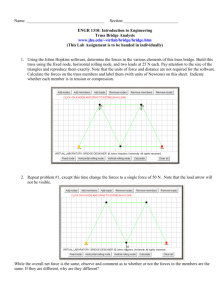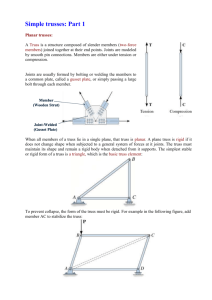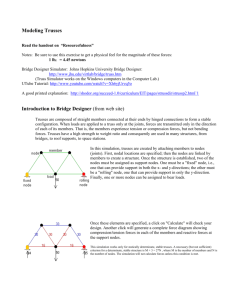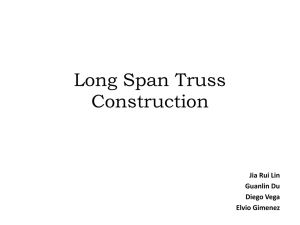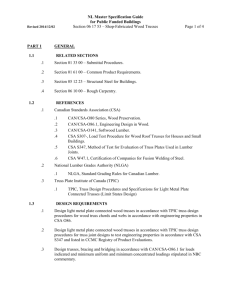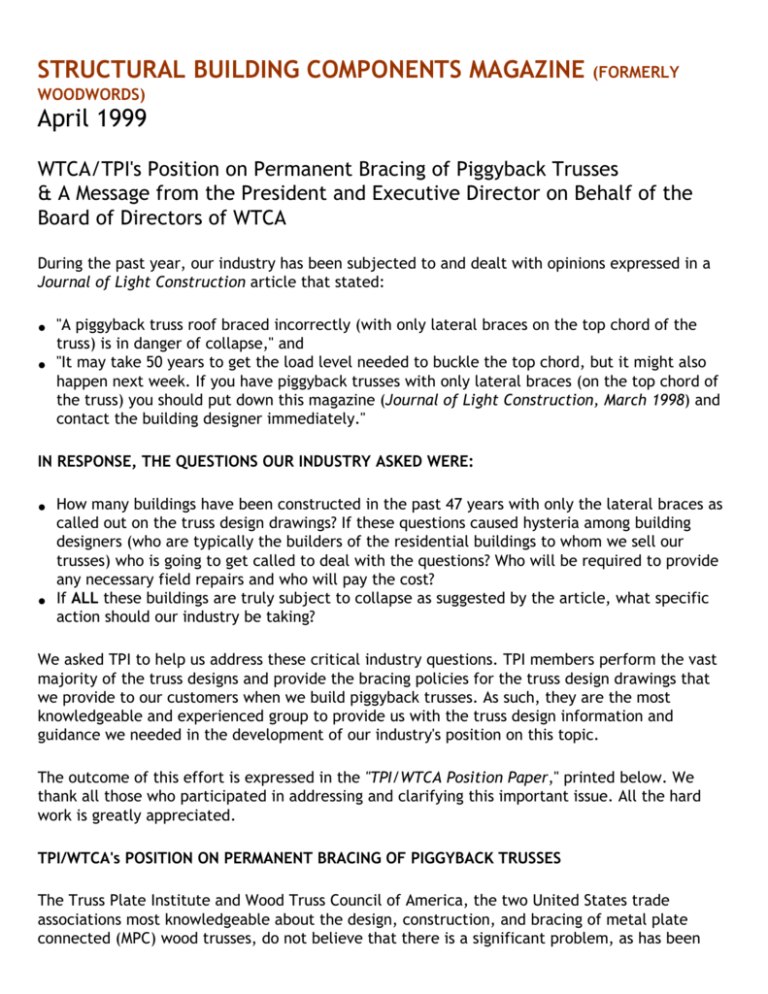
STRUCTURAL BUILDING COMPONENTS MAGAZINE
(FORMERLY
WOODWORDS)
April 1999
WTCA/TPI's Position on Permanent Bracing of Piggyback Trusses
& A Message from the President and Executive Director on Behalf of the
Board of Directors of WTCA
During the past year, our industry has been subjected to and dealt with opinions expressed in a
Journal of Light Construction article that stated:
●
●
"A piggyback truss roof braced incorrectly (with only lateral braces on the top chord of the
truss) is in danger of collapse," and
"It may take 50 years to get the load level needed to buckle the top chord, but it might also
happen next week. If you have piggyback trusses with only lateral braces (on the top chord of
the truss) you should put down this magazine (Journal of Light Construction, March 1998) and
contact the building designer immediately."
IN RESPONSE, THE QUESTIONS OUR INDUSTRY ASKED WERE:
●
●
How many buildings have been constructed in the past 47 years with only the lateral braces as
called out on the truss design drawings? If these questions caused hysteria among building
designers (who are typically the builders of the residential buildings to whom we sell our
trusses) who is going to get called to deal with the questions? Who will be required to provide
any necessary field repairs and who will pay the cost?
If ALL these buildings are truly subject to collapse as suggested by the article, what specific
action should our industry be taking?
We asked TPI to help us address these critical industry questions. TPI members perform the vast
majority of the truss designs and provide the bracing policies for the truss design drawings that
we provide to our customers when we build piggyback trusses. As such, they are the most
knowledgeable and experienced group to provide us with the truss design information and
guidance we needed in the development of our industry's position on this topic.
The outcome of this effort is expressed in the "TPI/WTCA Position Paper," printed below. We
thank all those who participated in addressing and clarifying this important issue. All the hard
work is greatly appreciated.
TPI/WTCA's POSITION ON PERMANENT BRACING OF PIGGYBACK TRUSSES
The Truss Plate Institute and Wood Truss Council of America, the two United States trade
associations most knowledgeable about the design, construction, and bracing of metal plate
connected (MPC) wood trusses, do not believe that there is a significant problem, as has been
suggested by others, with MPC wood trusses that are a component of a piggyback trussed roof
system. TPI, whose members manufacture truss plates and provide the designs for wood truss
components, and WTCA, whose members build trusses, based on their combined 47 years of
industry experience are able to state unequivocally that the number of reported instances of
piggyback truss performance problems is infinitesimal when compared with the number of
piggyback roof trusses in buildings.
What are piggyback trusses? Long span or high pitched MPC wood trusses which are too large to
be manufactured, shipped, and erected in one piece. At times, the building designer or truss
designer may choose to design trusses in two or more pieces to be assembled on the jobsite. In
general terms, a supporting-or -carrying truss that is topped with a smaller, supported (cap)
truss carried directly on top of the supporting truss is often referred to as a piggyback truss
assembly.
After an article raising concerns about the performance about MPC piggyback wood trusses
appeared in the March 1998 Journal of Light Construction, TPI conducted a preliminary
telephone survey of a limited number of forensic investigators and truss incidents to determine
whether it could reach a conclusion whether there was a problem or potential problem with
buildings containing piggyback trusses and, if so, the magnitude of the problem. TPI has not
been able to conclude, as the author suggests, that piggyback truss assemblies are in imminent
danger of collapse due to "incomplete bracing of the piggyback system." To the contrary, it
would appear that the number of incidences of piggyback trussed roofs experiencing
performance problems are de minimus when compared with the hundreds of thousands of
piggyback trusses sold, manufactured and erected in the U.S. each year. Further, it is impossible
based on available data to attribute any performance problem solely to one specific cause, such
as the lack of diagonal bracing, installing trusses out of plumb, installing damaged trusses,
inadequate anchorage of continuous lateral bracing, inadequate anchorage of trusses,
inadequate fastening of the diaphragm to the pitched portion of the truss, etc.
As described in a forthcoming* publication entitled; "COMMENTARY FOR PERMANENT BRACING OF
METAL PLATE CONNECTED WOOD TRUSSES" by John F. Meeks, P.E., with contributions from TPI's
Technical Advisory Committee and WTCA's Engineering Review Committee, it is important to
remember that while the truss designer and truss manufacturer may provide recommendations
for temporary bracing, it is up to the building designer (who is the individual or organization
responsible for the overall design of the building, and is typically one of the following - owner,
contractor, architect or engineer) to provide complete engineered structural framing systems,
including proper permanent bracing to support in-service loads both for piggyback and for other
type of trusses. The truss designer is not in a position to know how the building designer intends
to analyze and transfer loads due to the effect of vertical or lateral loads of the trusses on the
building or the effect of vertical or lateral loadings of the building on the trusses. The truss
designer only applies the loads determined by the building designer to the trusses he or she
designs.
The top chord of the piggyback truss assembly or supporting truss will require some type of
lateral restraint to prevent the top chord from buckling out from under the supported truss, and
from moving out of plane. This is most often accomplished by 4x2 dimension lumber continuous
lateral bracing. The required spacing of this bracing is generally provided on the truss design
drawing by the truss designer, together with the assumed thickness of the bracing and the
minimum connection requirements between the cap truss and the carrying truss.
It is imperative that the building designer, in turn, review this information and ensure that all
potential loading conditions have been accounted for. Further, the building designer must
integrate the truss member (chords & webs) requirements for continuous lateral bracing, as
specified by the truss designer, into the overall building design. The building designer can anchor
the continuous lateral bracing into solid end walls or other load resisting elements, and/or
stabilize the continuous lateral bracing with bays of diagonal bracing at intervals along the
length of the building, or some other equivalent means. If the building designer neglects
transferring the lateral top chord forces into the building, the top chord members and the
continuous lateral bracing can move in unison in the same direction. This type of shift may
gradually occur over time and may progressively worsen, although little is known about the
specifics of in-place system buckling and all the construction factors that may lead to in-place
performance problems. Our industry experience indicates that such occurrences are rare and are
usually caused by construction or installation practices that disregard bracing, bracing
anchorage, proper truss connection details, and/or proper nailing schedules. Regardless of all of
this, it is important for the building designer to assure that truss reactions (uplifts, horizontal
thrusts, and gravity) and truss member lateral forces are transferred into the building structure
which must have adequate strength to resist them.
Industry documents which provide recommended design and handling procedures for trusses
include ANSI/TPI 1-1995, WTCA 1-1995, and HIB-91. National Design Standard for Metal Plate
Connected Wood Truss Construction (ANSI/TPI 1-1995, model code approved), and Standard
Responsibilities in Design Process Involving Metal-Plate-Connected Wood Trusses. WTCA 1-1995
(pending ANSI approval as ANSI/TPI/WTCA 4-2000) both specify that the anchorage of the truss
and the stabilization and anchorage of continuous lateral bracing per truss design requirements
are the responsibility of the building designer. Commentary and Recommendations for Handling.
Installing & Bracing Metal Plate Connected Wood Trusses -HIB-91 recommends temporary
bracing for use during installation to hold trusses true to line and plumb and to prevent toppling
or dominoing collapse of the trusses. Most of the major building codes recognize HIB-91 as an
acceptable method of installation for many truss installation applications. The document,
however, is not intended to supersede the building designer's specific installation method for a
particular project.
TPI and WTCA will continue to review and provide information concerning piggyback and other
trusses their members design and build in their ongoing effort to responsibly design and build
structurally-sound trusses for integration by the building designer into buildings across America.
Towards this end, WTCA has formed a Product Safety and Loss Control Committee, which is
comprised of representatives having a broad exposure to the wood truss industry, such as
engineering, production, quality control, and business development. Among the many activities
of this committee will be receiving and acting on field reports and truss incidents where
appropriate, ensuring compliance with applicable regulations, standards and codes, and
educating truss manufacturers, building designers, contractors, owner and consumers on truss
product safety. The committee is furthermore committed to work on all issues in an immediate
manner. The committee and its representatives may be reached by contacting WTCA at 608/274-
4849, 608/274-3329 (fax). TPI may be reached at 608/833-5900, 608/833-3764 (fax).
WTCA's Board annually prepares its top priorities for the work it is undertaking for the
forthcoming year. This year, two of the top ten priorities are Temporary Bracing Revisions and
Permanent Bracing Issues Testing and Analysis. Our goal is to learn as much as we can about
these issues and provide sound guidance to our customers, so buildings will perform as expected
over their lifetime. Unfortunately, we are often called upon to single-handedly fix all the
problems that involve our product, and very often are blamed for building performance problems
that show up in the trusses, but which have nothing to do with the trusses or the work we have
undertaken.
Building design and construction is a very complex process of interrelated professions tackling
separate and distinct design and construction activities. If there is to be a solution to the gaps
that exist in this process, there needs to be a multidisciplinary approach to arriving at a solution.
The truss industry cannot take on this issue and solve it by itself, since we only have control over
the design and manufacture of the various components we have been contracted to provide to
the job.
If we are forced to seek solutions, which we may be, it will mean changing the way we currently
transact business. We will have to become the building designer of record and perform total
building engineering and design services. The real challenge is to resist the temptation to bury
these valuable services in the cost of the trusses, and slowly but surely erode our ability to get
paid for taking on the challenge and risks of performing complete building design. Our industry
challenge will be to watch this process over the next five-to-ten years and develop a strategic
plan that fits into the significant changes taking place.
SBC HOME PAGE
Copyright © 1999 by Truss Publications, Inc. All rights reserved. For permission to reprint materials from SBC Magazine,
call 608/310-6706 or email editor@sbcmag.info.
The mission of Structural Building Components Magazine (SBC) is to increase the knowledge of and to promote the
common interests of those engaged in manufacturing and distributing of structural building components to ensure growth
and continuity, and to be the information conduit by staying abreast of leading-edge issues. SBC will take a leadership
role on behalf of the component industry in disseminating technical and marketplace information, and will maintain
advisory committees consisting of the most knowledgeable professionals in the industry. The opinions expressed in SBC
are those of the authors and those quoted solely, and are not necessarily the opinions of any of the affiliated associations
(SBCC, WTCA, SCDA & STCA).


